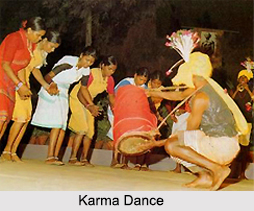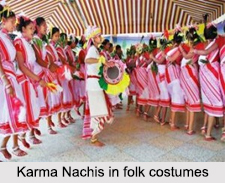 Karma dance is one of the important and oldest folk dances performed in the Madhya Pradesh state of India. Madhya Pradesh has a rich tradition of songs and dance. The tribal population of the state indulge themselves in many traditional performances and spends their leisure time singing and dancing. This Karma dance is mainly related to fertility cult.
Karma dance is one of the important and oldest folk dances performed in the Madhya Pradesh state of India. Madhya Pradesh has a rich tradition of songs and dance. The tribal population of the state indulge themselves in many traditional performances and spends their leisure time singing and dancing. This Karma dance is mainly related to fertility cult.
Karma Nachis
Karma dance is practiced by many aboriginal tribes like Gond tribe and Oraon tribe who mainly live in the north western part of Madhya Pradesh. These tribes also have their own form of dances many of which are not as primitive as are thought to be. Interestingly, Karma dance has many forms that are performed by many traditional tribes throughout India. In other parts of India it is also popularly known as Karma Naachis. It is performed by the tribes of Jharkhand, Chhattisgarh, Bihar, Odisha and other regions of the country. It is performed during the autumnal festival of Karma Puja. The tribal group performs this folk dance in front of Karam tree that signifies the Karam Devta, the God of Fate. The tribes believe that worshipping Karam Devta brings prosperity.
 Performance of Karma Dance
Performance of Karma Dance
It is performed in a group. Both male and female dancers participate in this dance. The dance is practiced around the trees set up in the villages. The dance is an amalgamation of various enthusiastic steps. The dancers make two rows facing each other. The male leap forward whereas the female bend low to the ground. Together they move their feet to and fro in a perfect rhythm.
Along with the dance, the musicians play a type of drum called a `timki` which they place on the ground between them. The dance is graceful to observe and is performed with measured steps. The dance usually continues all through the night and is watched by scores of spectators who gather from many miles to attend the occasion. While dancing, the performers of one row sing love-songs which are then repeated by the performers of other rows.
The dance is usually practiced during the beginning and the end of the rainy seasons. It can be watched in its full swing during the month of August when Karma festival is organized. At this time, the dancers are in full enthusiasm to exhibit their dancing skills.
Instruments of Karma Dance
In addition to drum, the other musical instruments that accompany this dance comprise the Thumki, Payri, Chhalla and Jhumki.
Costumes of Karma Dance
The dancers usually wear ethnic attire accompanied with traditional jewelleries. The costumes add brightness and intensity to the performance of the dance.
Sub Varieties of the Karma Dance
Karma dance has many sub varieties including the Sirki, the Jhumar, the Ghatwar, the Ektaria, the Pendehar, the Dohoari, the Lahaki and the Tegwani.



















